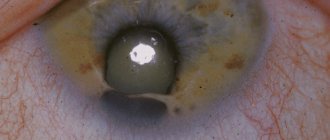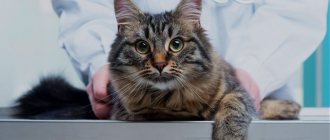What will you learn from the article?
- What causes cat flu
- How does infection occur? Risk group
- Incubation period
- Caring for a sick cat
Cat flu is a general name for highly contagious diseases of the upper respiratory tract of cats that are viral and bacterial in nature. These diseases have a general clinical picture reminiscent of ARVI. The causative agents of the disease are several different pathogenic microorganisms.
From our article you will learn whether cats get the flu, how the infection is transmitted, what methods of treating and preventing the disease are available, and whether a person can get infected from a cat.
What causes cat flu
This disease has several causative agents (pathogens):
- Feline herpesvirus FHV-1 (Feline Herpes Virus type 1) is the causative agent of infectious rhinotracheitis.
- Feline calicivirus FCV is the causative agent of calicivirus in cats.
- Chlamydophila Felis is the causative agent of chlamydia.
- Bordetella Bronchiseptica is a bacterium that affects the respiratory tract of cats and dogs (kennel cough).
Clinical signs of the disease, its methods of diagnosis and treatment depend on the type of pathogen.
How does infection occur?
Influenza in cats is a highly contagious (highly contagious) disease. Infection occurs through direct contact of a healthy animal with a sick animal or a carrier of the virus. Cats become infected through airborne droplets through saliva, tears and nasal discharge while playing together and living in the same room.
The second route of infection is contact through a contaminated environment (feeding utensils, toys, bedding, contaminated foods, tray, contaminated hands and human clothing). The virus survives in the environment for up to 7 days, so a healthy cat does not have to come into contact with a sick cat to become infected.
Some cats look healthy, but are “carriers” of the infection. They release viral particles and infect others.
Risk group
The disease is most dangerous for animals with weakened immune systems. Most often, stray cats and pets living in animal shelters become infected with cat flu.
Other risk groups:
- kittens;
- older cats and cats;
- unvaccinated cats;
- self-walking cats;
- animals that have undergone surgery and serious illnesses;
- cats with chronic diseases;
- cats whose immunity is suppressed due to cancer;
- cats living in large groups in one room;
- cats after taking medications that suppress the immune system.
The likelihood of infection is reduced if cats' habitats and care items are treated with disinfectants.
Incubation period
Cat flu has an incubation period of 2 to 14 days. But the first symptoms of the disease may appear in a cat already on the second day after contact with the carrier of the infection.
Flu in cats: symptoms, treatment
Cat flu is a viral infection that affects the lungs of an animal.
The pathology occurs in both mild and severe forms. It is not transmitted to humans.
Is the disease dangerous for the animal?
The course of the disease depends on the type of pathogen:
- Calicivirus is less dangerous and has a mild form. With early diagnosis and treatment it does not lead to complications. In kittens up to 6 months from birth, this virus can cause pneumonia.
- Herpesvirus causes severe pathology. The pathogen can infect not only the lungs, but also the entire body of the pet. Serious complications often develop and death is possible.
It is important to diagnose the disease promptly and correctly . The outcome of treatment depends on this.
Symptoms of infection
On average, it takes 2 to 10 days from infection to the onset of symptoms. Symptoms depend on the form of the influenza pathogen.
Symptoms of calicivirus:
- sneezing;
- nasal congestion;
- deterioration, lethargy;
- sores in the mouth.
Symptoms of herpes virus:
- conjunctivitis;
- heat;
- lethargy, low activity;
- loss of appetite;
- heavy salivation;
- nasal discharge;
- numerous ulcers in the mouth.
An advanced disease leads to intoxication, pneumonia, and arthritis. If symptoms are not treated promptly, the animal may die.
Causes of infection
The disease can develop if the following viruses enter the animal’s body:
- Calicivirus (Feline calicivirus). Affects the upper respiratory tract. Both domestic and wild individuals can become infected. Can be compared to the human cold.
- Herpesvirus (Feline Herpes Virus) or rhinotracheitis. The infection spreads through the respiratory tract throughout the animal's body. In addition to breathing problems, it affects the organs of vision. Often has complications, accompanied by a bacterial infection.
- Chlamydia Chlamydophila felis. Acts as a pathogen in cases of weak immunity.
The disease can also occur with the development of concomitant diseases that influence the development of the disease - obesity, leukemia, immunodeficiency.
Which cat can get sick?
Cats that have previously suffered from pneumonia are at risk. Their immunity is weakened, and the virus attacks the body faster. May get sick:
- kittens who have not received the vaccine;
- cats over 10 years old;
- adults not vaccinated against infections;
- pets from shelters walking on the street;
- cats who have suffered serious illnesses or surgeries;
- animals living in private houses.
Vaccination can keep an animal safe, so domestic cats and pets living in shelters should be vaccinated to prevent an outbreak of infection.
Diagnosis of the disease
If flu symptoms appear, you should contact a veterinary clinic.
The doctor performs a full examination and prescribes diagnostic procedures:
- general blood analysis;
- Analysis of urine;
- examination of secretions from the oral cavity and eyes for the presence of the virus using PCR;
- X-ray of the animal's chest.
Based on the examination results, the veterinarian chooses treatment tactics. Flu in cats is significantly different from human flu, so it is forbidden to choose tablets for your animal yourself .
Treatment of infection
For flu that occurs without complications, treatment takes place at home. It is aimed at relieving symptoms caused by infection.
In case of severe illness, the cat is hospitalized in a clinic, where it is under the supervision of specialists until complete recovery.
Home therapy
The method of treating the disease at home includes the following measures and medications:
- Inhalations using a nebulizer (aimed at liquefying and removing sputum).
- Injections. Interferon injections will help the body cope with the virus faster.
- Eye medications - Cidofovir, Trifluridine. Drops are prescribed for eye conjunctivitis and excessive lacrimation.
- Antiviral drugs - Maxidin, Fosprinil.
- If the body temperature is elevated, an antipyretic drug is prescribed to alleviate the cat's condition.
- Antibiotics are prescribed when lung damage or re-infection with influenza occurs. Also aimed at preventing the occurrence of bacterial infection.
In case of severe pain, the pet is given analgesics. They make the animal feel better.
Caring for a sick cat
Home care includes not only drug treatment.
Tips for owners:
- Give all prescribed medications as directed.
- Provide your mustachioed pet with access to clean drinking water. If the animal cannot drink on its own, inject the liquid using a syringe. This prevents the body from becoming dehydrated.
- If you lose your appetite, you should purchase good quality food for your pet. It is better to choose a diet food for kittens.
- If the cat does not eat on its own, it is fed liquid food using a special tube.
- Thoroughly wash the area where the cat rests and eats, and regularly disinfect the litter tray.
- Isolate your pet from other healthy animals.
- Avoid active games with the cat.
Virus carriers: are they dangerous to others?
Animal flu, which affects cats, is not dangerous to humans. This strain is transmitted only between cats. A person cannot get sick from an animal.
https://www.youtube.com/watch?v=AlUaRfTmh8I
When you are sick, you should not be afraid of your pet. It is necessary to provide him with proper care. It is better to house other animals separately from the patient so that they do not become infected.
How the infection spreads
An animal can become infected in two ways:
- Upon contact with a carrier of infection. The virus is transmitted by airborne droplets, even if the sick pet has no visible symptoms. During the incubation period, which lasts from 2 to 10 days, the animal is a carrier of the disease.
- Infection is indirect. In this way, cats in shelters and foster care are more often infected. This happens because pets eat from the same bowls and have a common bed. Failure to comply with sanitary standards leads to the development of the disease.
The first symptom is runny nose . Having discovered it, the sick animal should be immediately removed from the rest of the pets.
Conclusion
Influenza in cats is caused by viruses such as calicivirus or herpesvirus.
The main symptoms are runny nose, sneezing, discharge from the nose and eyes. For diagnosis, a PCR test is performed.
Treatment is carried out using antibiotics and inhalation. Antiviral therapy is being carried out. To prevent influenza, timely vaccination is necessary.
Previous Did this article help? Rate it Loading...
Source: https://nashakisa.ru/zdorove/bolezni/koshachiy-gripp.html
Symptoms of cat flu
Symptoms of the disease depend on what microorganism causes the flu. Your cat may show one or more symptoms depending on the severity of the disease.
The following signs indicate cat flu:
- sneezing is the main way of spreading infection;
- runny nose, nasal congestion, purulent nasal discharge;
- conjunctivitis, discharge from the eyes, ulcers on the eyes;
- watery eyes;
- cough;
- difficult, noisy breathing;
- profuse drooling;
- hyperthermia, fever;
- ulcers on the nose, mouth and tongue;
- loss of appetite;
- loss of voice;
- changes in behavior;
- weakness, lethargy.
If one or more symptoms appear, you should take your cat to a veterinarian. In the absence of timely treatment, serious complications are possible (pneumonia, exhaustion, dehydration, sore throat).
It is not worth risking your pet's health; in advanced cases, death is possible. The mortality rate among kittens can reach 100%.
Cat flu – Veterinary service of the Vladimir region
Cat flu is a term used by veterinary specialists for diseases caused by pathogens of viral infections and accompanied by damage to the upper respiratory tract.
Like human flu epidemics, cat flu is a highly contagious disease affecting the cat family in a city, region, etc.
Which cat is most susceptible to the flu?
Considering the fact that feline influenza is one of the most common viral diseases among the cat family, it is almost always present in this animal population. Among cats, the most common cases of influenza are:
- Elderly cats and kittens over 2 months of age.
- Cats kept in nurseries, shelters, etc., where there are conditions for the rapid spread of influenza.
- Cats with reduced immunity (feline immunodeficiency virus, patients with leukemia).
- Not vaccinated against viral infectious diseases.
Pathogens of cat flu
The main causative agent of influenza during epidemics is the infectious rhinotracheitis virus, which is a DNA-containing virus from the herpes virus family. A temperature of 56°C leads to inactivation of the virus within 20 minutes, direct sunlight kills the virus within 48 hours. Conventional disinfectants inactivate the virus almost instantly.
The second most widespread infection in cats is feline calcivirus.
The causative agent of chlamydia, Chlamydophila felis (chlamydia in cats), may be involved in an outbreak of influenza in cats.
The next pathogen that is isolated in veterinary laboratories during an influenza outbreak is Bordetella bronchiseptica.
Symptoms of cat flu
The incubation period for cat flu ranges from 2 to 10 days.
The influenza virus is transmitted from a sick animal or virus carrier to a healthy animal by airborne droplets through the mucous membranes of the oral and nasal cavities and the conjunctiva of the eyes.
It is also possible for a cat to become infected through contact through contaminated food, bedding, cups and other utensils used to feed the cat.
Symptoms characteristic of influenza are a runny nose (a runny nose in a cat), constant sneezing, symptoms of conjunctivitis, fever, and fever. A sick cat becomes lethargic and loses its appetite. Moreover, if the causative agent of influenza is a herpes virus infection (infectious rhinotracheitis in cats), the disease is more severe.
If the flu is caused by a calcium virus infection in cats, the cat will become ill in a milder form. During an outbreak of influenza in cats, a viral infection is often accompanied by a secondary bacterial infection, which can lead to pneumonia in a cat (pneumonia in a cat), bronchitis (cough in a cat), and the development of chronic rhinitis.
Diagnosis of influenza in cats
Diagnosis of influenza in cats is carried out by a veterinary specialist at the clinic. The diagnosis of influenza in a cat is made comprehensively, taking into account the epizootic situation in the city, a clinical examination of the sick animal, and symptoms of the disease.
The diagnosis of influenza is made based on the results of a laboratory test collected with a swab from the eyes or mouth. The veterinary laboratory will grow a culture of the virus and conduct research using polymerase chain reaction (PCR), which allows detection of virus genes at the molecular level.
If there are complications, veterinary specialists prescribe additional tests - blood test, urine test, chest x-ray, ultrasound.
Preventing influenza in cats
The main place in the system of preventive measures for influenza is occupied by specific prevention - vaccination of cats against viral diseases registered in your region.
All cats should be vaccinated against herpesvirus infection. Kittens starting from 2 months of age should undergo a vaccination course consisting of two to three vaccinations (which are carried out after 3 weeks). After the cat has reached one year of age, we carry out revaccination, and then revaccination is carried out annually throughout its life.
Today, the following vaccines are used as specific means of prevention for infectious rhinotracheitis: Multifen -3 against panleukopenia, rhinotracheitis, calcivirus infection of cats. Multifel-4 against panleukopenia, rhinotracheitis, calcivirus infection and chlamydia in cats. Nobivak, Quadrikat, Leukorifelin.
Animal owners should keep in mind that only healthy animals can be vaccinated. 5-7 days before the intended vaccination, it is necessary to carry out deworming against worms (worms in cats).
For each cat it is necessary to use separate dishes and litter trays.
Indoors, owners must carry out periodic disinfection with hypochlorite.
Source: https://vetvo.ru/gripp-koshek.html
Diagnostics
Diagnosis is carried out in a veterinary clinic after a comprehensive assessment of the animal’s condition, taking into account the epidemiological situation in the cat’s place of residence. The doctor examines the animal, assesses its condition, and analyzes the clinical picture of the course of the disease.
Additionally, laboratory tests are carried out:
- urine and blood analysis;
- PCR – growing virus strains from swabs taken from a cat’s mouth and eyes;
- Ultrasound;
- radiography.
Additional diagnostics are necessary in severe and advanced cases, when signs of a secondary disease are clearly expressed.
Flu in cats: symptoms, treatment and prevention
Pets can get the flu just like regular people. In this case, it is necessary to promptly respond to all symptoms that appear, consult a veterinarian and begin treatment as a matter of urgency. Without taking the necessary measures, the health and even life of the cat may be in danger.
Is there cat flu?
Many cat owners wonder what cat flu is. This virus is not transmitted from humans; animals most often become infected from their relatives. Therefore, the disease is often transmitted between cats living in shelters. There are also other risk groups:
- cats without vaccines;
- kittens (due to weak immunity);
- older cats;
- cats whose immunity has been suppressed due to cancer or taking medications that affect the immune system.
The cause of influenza in cats is infection with the rhinotracheitis virus or calicivirus.
Symptoms and treatment
The disease can be identified in a pet by a number of characteristic signs:
- heat;
- sneezing and coughing;
- profuse salivation and tear production;
- nasal discharge;
- lack of appetite;
- lethargy, weakness;
- in some cases - the formation of ulcers in the mouth.
If the owner observes at least one obvious symptom in his cat, it is necessary to go for an examination to a veterinarian - the doctor, based on the complaints, will prescribe tests and will soon be able to make a diagnosis.
If cat flu is confirmed, treatment should also be prescribed exclusively by a specialist.
Important!
Cat flu is significantly different from human flu, and any attempts to cure the animal on your own can not only delay recovery, but also aggravate the situation.
Depending on the pathogen, the flu in a cat can occur in different ways. When the disease was caused by a herpes virus infection, the clinical signs are more pronounced; the cat has conjunctivitis.
If the causative agent is a calicivirus infection, the disease is milder. However, small kittens with severe influenza may develop pneumonia, as well as passing arthritis.
Diagnostics
Influenza in cats is an upper respiratory tract disease. The doctor, analyzing the signs, makes a conclusion about the diagnosis, but sometimes may prescribe additional tests.
To conduct them, you need to collect samples of discharge from the eyes, as well as a sample of saliva.
The genes of the virus can also be detected at the molecular level using a special PCR test.
Treatment
The doctor prescribes medications aimed at fighting the infection and alleviating symptoms. The drugs must be given to the animal in the prescribed quantity for the period specified by the doctor. These factors may vary depending on the severity of the disease and severe symptoms, as well as the age of the cat.
At home
Any owner can treat their cat at home, having previously purchased all the medications necessary for treatment. Most often, doctors prescribe antibiotics and antiviral drugs.
- Treatment with medications. The pet needs antibiotics to fight infection (for example, Clamoxil), antiviral drugs and agents whose action is aimed at improving intestinal microflora.
- To combat loss of appetite, you can give your cat high-quality flavored wet food. In addition, we must not forget to constantly change the water in the drinking bowl, monitoring its freshness and quantity.
- If your cat has breathing problems, inhalations will be required to loosen the blockages in the respiratory tract.
- Injections of interferon may be prescribed, which will strengthen the body's resistance to infection.
- For eye diseases, special ointments or drops are prescribed - cidofovir, trifluridine, etc.
Caring for a sick cat is very important: if the animal’s condition worsens, hospitalization may be required. For example, if you have anorexia, you will need to feed your cat through a tube, and if your pet refuses water, you will need intravenous fluids. Such measures will speed up recovery.
If the doctor notices that the animal is in pain, he will prescribe analgesics. In other cases, additional medications may be needed to eliminate unpleasant symptoms and alleviate the cat’s condition.
Reference!
Some medications can be dissolved in water or mixed with food, so as not to torment the animal by swallowing bitter tablets.
Is it necessary to go to a veterinary clinic?
Since today there are a huge number of infectious diseases of pets with similar symptoms. Therefore, under no circumstances should you begin treatment without a visit to the veterinary clinic.
The cat should be examined by a specialist who, if necessary, will prescribe additional tests and be able to make a correct diagnosis.
Treatment is also always prescribed depending on many factors, especially the stage of development of the disease. The cat's owner is not able to assess the problem from a medical point of view, and even if the medications are chosen correctly, a specific dosage of all medications will be required for them to be effective.
Is cat flu dangerous for humans?
Some cat owners are concerned about whether the virus can be transmitted to humans. There is no need to worry about such an infection: this disease is transmitted only between animals and does not pose a danger to humans.
Attention!
There is no need to be afraid of getting infected from a cat, especially since a weakened, sick pet on days like these needs care and attention more than ever.
Give your cat more time and be sure to provide her with the necessary care: the animal will definitely be grateful to you, even if you give an injection or pills.
Treatment at home
Since the disease is viral in nature, there are no specific drugs that can completely eliminate it. Therapy is aimed at maintaining the cat’s condition, strengthening its immunity, and relieving symptoms of the disease. All therapeutic measures and medications must be prescribed by a veterinarian, taking into account the condition of the cat, its age and the causative agent of the disease.
The treatment regimen includes:
- Antiviral drugs for cats (
, Cycloferon, Forvet, Kamedon, Anandin). - Antibiotics (Cephalosporins, Clamoxil).
- Immunostimulants (Gamavit).
- Steam inhalation for breathing problems.
- Interferon to strengthen the body's resistance.
- Rinsing the nose and eyes with special means.
- Eye ointments and drops for conjunctivitis (cidofovir, trifluridine).
- Painkillers.
- Antipyretics for fever.
- Drink plenty of fluids.
- Dropper for complete refusal of food.
Use medications only as prescribed by your veterinarian.
Caring for a sick cat
An important part of effective treatment is special care for the cat. The first thing to do is to isolate the sick animal from healthy pets.
- Give your pet water to prevent dehydration. If the cat refuses to drink on its own, forcefully inject water into its mouth using a syringe without a needle or syringe.
- Switch your cat to soft liquid food if he refuses to eat dry food.
- Add strong-smelling foods (liver, fish, wet food) to your cat's food to increase your cat's appetite.
- Clean your pet's eyes thoroughly with a cotton swab dipped in boiled water.
- Regularly ventilate and humidify the air in the rooms where the cat is located.
- Carry out wet cleaning of premises with disinfectants daily.
How long does the disease last?
From the appearance of the first clinical symptoms to complete recovery in mild cases of the disease, 5 to 10 days pass. In severe cases, the disease lasts up to 6 weeks. The duration depends on the condition of the animal, its age and the type of pathogen.
If cat flu is caused by a strain of herpes, cats remain infected for the rest of their lives. The first time the infection is most severe, subsequent relapses are more easily tolerated. Repeated cases are caused by decreased immunity and stress.
Influenza caused by the calicivirus FCV is usually more easily tolerated by cats, but it may take several weeks for complete recovery to occur. After treatment, animals can remain carriers of the infection for several months, so they must be kept in quarantine.
Treatment
Remember that a cat’s cold is not the worst disease, but you shouldn’t hope that it will go away on its own. If you notice signs of a cold, do not ignore them: it is better to take your cat to the veterinarian than to wait for the situation to get worse.
The correct treatment regimen is prescribed only after the pet has been examined by a doctor and a diagnosis has been established. It is prohibited to take measures on your own - this can harm the animal and worsen the situation.
The owner’s task is to provide the cat with the most comfortable conditions for recovery. Measures taken to achieve this should include:
- eliminating drafts;
- control over keeping the pet warm;
- providing the cat with warm drinks, including milk;
- You can give your cat a massage - this will improve blood flow and warm the animal.
The doctor may prescribe rinsing the nose with special drops. If inflammation is detected, it is necessary to give the cat anti-inflammatory drugs, and if the temperature is high, antipyretics.
In some cases, the doctor will prescribe antibiotics to kill infections. In this case, additional medications may be prescribed to restore the intestinal microflora.
For a cat, a cold is an unusual occurrence, and visiting a veterinarian and taking pills is stressful for an animal. Therefore, give your pet enough time and attention so that he does not feel lonely.
You can reward your cat with a treat after she eats a pill or visits the vet.
The lack of therapeutic measures can lead to complications and the development of other diseases, which include bronchitis, pneumonia, and kidney disease.
Prevention
It is impossible to completely protect your cat from this disease, but you can reduce the risk of infection by following these simple prevention rules.
Preventive actions:
- Vaccination. Vaccinations do not provide a 100% guarantee, but they significantly reduce the likelihood of infection. You should follow the vaccination schedule recommended by your veterinarian.
- Strengthening the immune system with vitamins and immunostimulants.
- Follow the rules of kitten care and hygiene. Regularly wash and disinfect the litter box, dishes and the cat’s area.
- Protect your pet from hypothermia.
- Provide quality food.
- Do not let cats roam, avoid contact with stray cats and dogs.
When the first signs of illness appear, the animal should be quarantined and shown to a veterinarian.
Who can become a carrier of the virus
The group of cats that can become carriers of the cat influenza virus includes:
- Unvaccinated cats.
- Kittens.
- Older cats.
- Pets with weakened immune systems.
- Pets suffering from any disease.
- Pets that have experienced stressful situations and overexertion.
- Animals during the period of acclimatization.
- Pregnant or postpartum cats.
- Several cats living in one room.
The cat flu virus remains inside the pet after recovery, so they will always be considered a carrier of it.








